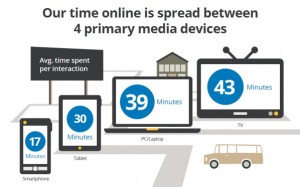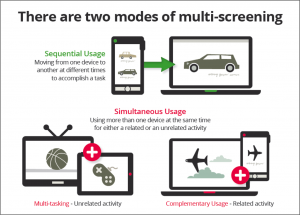Google has released some interesting data confirming what most of us have already accepted as a given in our daily lives – we use multiple screens to consume media every day. But it’s HubSpot’s interpretation of the data that I particularly like, click here to read the 34 insights about multi-screen media consumption that HubSpot pulled out of this data. I’ll focus on just a couple of statistics.
 Of the 4.4 hours of “leisure time” we spend in front of a screen each day, we spend 43 minutes watching TV (seems low to me), 39 minutes on our laptop or PC’s (not low for leisure time but I would spend between 8-12 hours in front of a laptop some days), 30 minutes on a tablet (also seems light) and 17 minutes on a smartphone. While these don’t seem a lot, I guess it depends how Google has categorised leisure time and of course its an average – so I’m not a fair representation of screen usage behaviour.
Of the 4.4 hours of “leisure time” we spend in front of a screen each day, we spend 43 minutes watching TV (seems low to me), 39 minutes on our laptop or PC’s (not low for leisure time but I would spend between 8-12 hours in front of a laptop some days), 30 minutes on a tablet (also seems light) and 17 minutes on a smartphone. While these don’t seem a lot, I guess it depends how Google has categorised leisure time and of course its an average – so I’m not a fair representation of screen usage behaviour.
38% of our daily media interactions occur on a smartphone. This seems more like it to me. When I look around me on the bus, in supermarkets, while walking the dog in a park, in business meetings – people everywhere are staring at their smartphones. Are you one of them?
Of the time we spend using our smartphone to consumer media, 54% of smartphone use is motivated by communication & 33% by entertainment and of our PC/ laptop media consumption, 60% at home, while 40% occurs out of home (at work or on the go).
Sequential and simultaneous screen usage

We tend to use our many screens daily to either follow a task sequentially from one screen to another or simultaneously, consuming both devices at the same time.
Google’s research has clearly identified two ways that we consumer media across multiple screens. Simultaneous screen usage is best represented by Social TV. I’m sure many of you are familiar with and participate in Social TV, the habit of tweeting, posting and commenting on TV shows while they happen. This phenomenon is not only significant for reality TV shows but also for news, political programs as well as comedy and drama.
Sequential multiple screen device usage is more often related to task related activities, such as shopping online, reading and replying to emails, booking accommodation or travel. What this tells us is that we may use our smartphone or tablet to research, investigate and watch flights and items for sale/ auction, but we then complete the task when we get to a laptop or PC. In fact, 90% of us use multiple screens sequentially to accomplish a task over time and we use an average of 3 different screens every day (assuming TV, PC/ laptop and smartphone). But it seems that tablets are the most common place where users start online shopping or planning a trip. Interesting.
So, what does this tell you? Hopefully you’re starting to believe what I’ve been telling you for the last 2 years – that businesses need to consider their customer’s experience across all touchpoints and devices and ensure that they have a great online user experience no matter if they’re visiting your brand via your website on a PC or laptop or on their smartphone. I have many blog posts on mobile marketing strategy and how to decide what mobile strategy is best for your business – mobile site or mobile app as well as whether that app is Apple or Android?
If you have already invested in mobile marketing in the form of a “mobile optimised website” or a mobile site or app – good for you. But make sure you are optimising that experience for all devices, Apple or Android or Windows phones, as well for all screen sizes and hardware capabilities. I know, there is so much to think about, but isn’t it cool!!!
And here is the full infographic from Google’s research, click to download multi-screen_infographic

Wonderful article!! Thanks for sharing and helping us all keep up to date on what’s important in sydney.